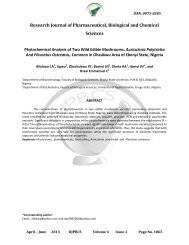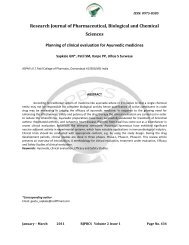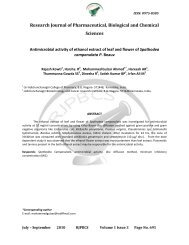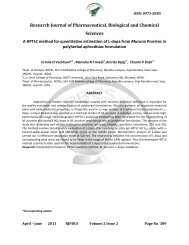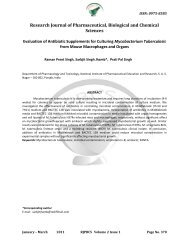Research Journal of Pharmaceutical, Biological and Chemical ...
Research Journal of Pharmaceutical, Biological and Chemical ...
Research Journal of Pharmaceutical, Biological and Chemical ...
You also want an ePaper? Increase the reach of your titles
YUMPU automatically turns print PDFs into web optimized ePapers that Google loves.
ISSN: 0975-8585<br />
<strong>Research</strong> <strong>Journal</strong> <strong>of</strong> <strong>Pharmaceutical</strong>, <strong>Biological</strong> <strong>and</strong> <strong>Chemical</strong><br />
Sciences<br />
Analgesic <strong>and</strong> anti-inflammatory activities <strong>of</strong> Buchanania lanzan Spreg. Roots<br />
Patsnaik AK 1 , Kodati D 1 , Pareta SK 2 *, Patra KC 2 , Harwansh RK 2<br />
1 Department <strong>of</strong> <strong>Pharmaceutical</strong> Sciences, Birla Institute <strong>of</strong> Technology, Mesra, Ranchi- 835215 India<br />
2 S.L.T. Institute Of <strong>Pharmaceutical</strong> Sciences, Guru Ghasidas University, Bilapur-495009 India<br />
ABSTRACT<br />
Buchanania lanzan Spreng plant is well known for its medicinal <strong>and</strong> therapeutic values in Indian folk<br />
medicine. However, to be clinically useful, more scientific data are needed. Therefore, in the present study, we<br />
investigated the effects <strong>of</strong> root <strong>of</strong> Buchanania lanzan Spreng. methanolic extract (MBL) on pain <strong>and</strong> acute<br />
inflammation. To assess the analgesic activity <strong>of</strong> varied concentrations <strong>of</strong> the MBL (200 <strong>and</strong> 400 mg/kg orally)<br />
acetic acid-induced writhing model in mice <strong>and</strong> hot plate reaction time model in rats was used. Anti-inflammatory<br />
activity was tested in carrageenan-induced rat paw oedema model. The writhes in experimental rats were reduced<br />
significantly as compared to that <strong>of</strong> control, <strong>and</strong> hot plate test showed significant licking effect in rats. Paw<br />
volumes was significantly reduced in treated animals. Results clearly indicate that the Buchanania lanzan Spreng<br />
could be a potential source for using as anti-inflammatory <strong>and</strong> analgesic agent.<br />
Keywords: Buchanania lanzan, analgesic, anti-inflammatory, roots<br />
*Corresponding author<br />
E-mail:surendra.pareta@gmail.com<br />
January – March 2011 RJPBCS Volume 2 Issue 1 Page No. 419
INTRODUCTION<br />
ISSN: 0975-8585<br />
Medicinal herbs have been used as a form <strong>of</strong> therapy for the relief <strong>of</strong> pain throughout<br />
history. Natural products in general <strong>and</strong> medicinal plants in particular, are believed to be an<br />
important source <strong>of</strong> new chemical substances with potential therapeutic efficacy. Taking into<br />
account the most important analgesic prototypes (e.g. salicylic acid <strong>and</strong> morphine) were<br />
originally derived from the plant sources, the study <strong>of</strong> plant species traditionally used as pain<br />
killers should still be seen as a fruitful research strategy in the search <strong>of</strong> new analgesic <strong>and</strong> antiinflammatory<br />
drugs [1].<br />
Inflammation is considered as a primary physiologic defense mechanism that helps body<br />
to protect itself against infection, burn, toxic chemicals, allergens or other noxious stimuli. An<br />
uncontrolled <strong>and</strong> persistent inflammation may act as an etiologic factor for many <strong>of</strong> these<br />
chronic illnesses. Although it is a defense mechanism, the complex events <strong>and</strong> mediators<br />
involved the inflammatory reaction can induce, maintain or aggravate many diseases. Currently<br />
used anti-inflammatory drugs are associated with some severe side effects. Therefore, the<br />
development <strong>of</strong> potent anti-inflammatory drugs with fewer side effects is necessary [2].<br />
India is a rich source <strong>of</strong> medicinal plants <strong>and</strong> a number <strong>of</strong> plant derived oils <strong>and</strong> extracts<br />
are used against diseases in various systems <strong>of</strong> medicine such as Ayurveda, Unani <strong>and</strong> Siddha.<br />
Only a few <strong>of</strong> them have been scientifically explored. Plant derived natural products such as<br />
flavonoids, terpenes <strong>and</strong> alkaloids [3] have received considerable attention in recent years due<br />
to their diverse pharmacological properties including inflammatory, antipyretic <strong>and</strong> analgesic<br />
activities.<br />
Buchanania lanzan Spreng. (family: Anacardiaceae) commonly known as Char in hindi is<br />
Subdeciduous tree, 13-17m high <strong>and</strong> upto 1.3m in girth, dark grey bark, Leaves alternate,<br />
petiolate, very coriaceous or hard sessile Flowers, greenish white in colour <strong>and</strong> stone hard bi-<br />
valved, kernel has a pleasant sweetish acidic flavor; found throughout the hot dried parts <strong>of</strong><br />
India [4].Tribal people <strong>of</strong> Jharkh<strong>and</strong> <strong>and</strong> Chhattisgarh are using Buchanania lanzan Spreng.<br />
Mainly for wound healing, anti-diarrhoeal, analgesic <strong>and</strong> antiulcer activity apart from in other<br />
conditions, but no scientific study has been carried out regarding its pharmacological activities.<br />
Therefore present study designed to evaluate the Analgesic <strong>and</strong> anti-inflammatory activity <strong>of</strong><br />
Buchanania lanzan Spreng.<br />
MATERIALS AND METHODS<br />
Plant material identification <strong>and</strong> extraction<br />
Buchanania lanzan Spreng roots were collected in September 2008 from B.I.T. Mesra,<br />
Ranchi India. Further taxonomic identification was done Dr. S. Jha, Associate Pr<strong>of</strong>essor, Dept. <strong>of</strong><br />
Pharmacognosy, BIT, Mesra, Ranchi. The roots were dried in shade for 15 days <strong>and</strong> to ensure<br />
complete dryness plant roots were kept in hot air oven at 45˚C for 10 minutes. Then roots were<br />
subjected to size reduction to make coarse powder <strong>and</strong> passed through 40-mesh sieve <strong>and</strong><br />
January – March 2011 RJPBCS Volume 2 Issue 1 Page No. 420
ISSN: 0975-8585<br />
stored in an airtight container for further use. The dried <strong>and</strong> powdered roots were subjected to<br />
hot extraction in Soxhlet apparatus with methanol.<br />
Animals<br />
Swiss albino mice weighing 25–30gm <strong>of</strong> either sex were used in the study. Animals were<br />
procured from Laboratory Animal House <strong>of</strong> Birla Institute <strong>of</strong> Technology, Mesra (Reg. no.:<br />
621/02/ac/CPCSEA). All animal experiments strictly complied with the approval <strong>of</strong> institutional<br />
animal ethical committee. The animals were kept in polyacrylic cages <strong>and</strong> maintained under<br />
st<strong>and</strong>ard housing conditions <strong>of</strong> temperature (24-27°C) <strong>and</strong> humidity (60-65%) with 12:12<br />
light: dark cycles. They were acclimatized for seven days. Food was provided in the form <strong>of</strong> dry<br />
pellets <strong>and</strong> water ad libitum.<br />
Acute toxicity assay<br />
Acute toxicity assay was performed in mice according to OECD guidelines. Animals were<br />
divided into different groups <strong>of</strong> six each. After an overnight fast, the test drug was administered<br />
orally in graded dose (100–2000 mg/kg). In further, they were observed continuously for the<br />
first 2 h for toxic symptoms <strong>and</strong> up to 24 h for mortality. There was no lethality in any <strong>of</strong> the<br />
groups after treatment [5].<br />
Analgesic activity<br />
Acetic acid-induced writhing test in mice<br />
For the analgesic activity assay, acetic acid solution (15 mg/ml) at the dose <strong>of</strong> 300 mg/kg<br />
body weight was injected (i.p.) <strong>and</strong> the number <strong>of</strong> writhes during the following 15 minute<br />
period was observed [6]. A significant reduction in the number <strong>of</strong> writhes by drug treatment<br />
(MBL 200 <strong>and</strong> 400 mg/kg, p.o.) as compared to vehicle treated animals was considered as a<br />
positive analgesic response. The percentage inhibition <strong>of</strong> writhing was then calculated. Aspirin<br />
(100 mg/kg, p.o.) was used as st<strong>and</strong>ard drug.<br />
Hot plate reaction time in rats<br />
Rats were screened by placing them on a hot plate maintained at 55 ± 1ºC <strong>and</strong> the<br />
reaction time in seconds for hind paw licking or jumping were recorded [6]. The rats were orally<br />
administered the test drug (MBL 200 <strong>and</strong> 400 mg/kg, p.o.). Only rat which reacted within 15s<br />
<strong>and</strong> which did not show large variation when tested on four separated occasions, each 15 min<br />
apart, were used in this study. Pentazocine (10 mg/kg body weight, p.o.) was used as st<strong>and</strong>ard.<br />
The time for hind paw licking or jumping on the heated plate <strong>of</strong> analgesiometer was taken as<br />
the reaction time.<br />
January – March 2011 RJPBCS Volume 2 Issue 1 Page No. 421
Anti-inflammatory activity<br />
Carrageenan-induced paw oedema in rats<br />
ISSN: 0975-8585<br />
Carrageenan-induced paw edema was examined in female rats according to the method<br />
<strong>of</strong> Winter et al. (1962) [7]. Acute inflammation was produced by injecting 0.1 ml <strong>of</strong> (1%)<br />
carrageenan into plantar surface <strong>of</strong> rat hind paw. The test samples <strong>of</strong> MBL (200 <strong>and</strong> 400 mg/kg,<br />
orally), <strong>and</strong> Aspirin (300 mg/kg, orally) as reference agent were administered 60 min before<br />
carrageenan injection. The paw volume was measured at 1<strong>and</strong> 3 h, using a thread to determine<br />
the diameter <strong>of</strong> oedema formation size. Before oral administration <strong>of</strong> drugs, the average<br />
volume <strong>of</strong> the right hind paw <strong>of</strong> each animal was measured two times (Vo) by a digital<br />
plethysmometer. The volume <strong>of</strong> right hind paw was determined again at 1 <strong>and</strong> 3 h after<br />
carrageenan treatment (Vt). The percent inhibition in increase <strong>of</strong> edema volume for each<br />
animal group was calculated by the following formula,<br />
Analgesic Activity<br />
% inhibition <strong>of</strong> edema<br />
RESULTS<br />
MBL indicated significant <strong>and</strong> dose dependent analgesic activity against both thermally<br />
<strong>and</strong> chemically induced pain. In acetic acid induced writhing method MBL (200 <strong>and</strong> 400 mg/kg,<br />
p.o.) <strong>and</strong> st<strong>and</strong>ard (Aspirin 100 mg/kg, p.o.) treated animals showed significantly reduced<br />
number <strong>of</strong> writhing in 15 min at the rate <strong>of</strong> 13.96%, 39.29% <strong>and</strong> 60%, respectively, when<br />
compared with control group. Analgesia produced by MBL 400 mg/kg was more significant (p <<br />
0.01) when compared to that <strong>of</strong> MBL 200 mg/kg.<br />
Number <strong>of</strong> Writhings<br />
60<br />
40<br />
20<br />
0<br />
Control<br />
Aspirin<br />
MBL 200<br />
MBL400<br />
Figure 1: Effect <strong>of</strong> the methanolic extract <strong>of</strong> Buchanania lanzan roots on acetic acid induced writhing<br />
January – March 2011 RJPBCS Volume 2 Issue 1 Page No. 422
ISSN: 0975-8585<br />
Table 1: Effects <strong>of</strong> the methanolic extract <strong>of</strong> Buchanania lanzan roots on hot plate test in mice.<br />
Treatment Dose(mg/kg) Mean reaction time (sec)<br />
0 30 60 90<br />
Control -- 3.48±0.08 3.66±0.06 3.62±0.12 3.52±0.10<br />
Pentazocine 100 3.84±0.04 5.98±0.20** 6.94±0.13** 7.82±0.88**<br />
Methanol extract 200 3.38±0.05 3.74±0.10 3.82±0.8 3.56±0.16<br />
400 3.78±0.07 3.88±0.08 4.04±0.15 4.17±0.17<br />
Each value is the mean ± S.E.M. <strong>of</strong> six mice.<br />
**p < 0.01 vs. control, One way ANOVA followed by Dunnet’s t-test<br />
Anti-inflammatory activity<br />
The results <strong>of</strong> the anti-inflammatory effect <strong>of</strong> MBL on carrageenan-induced oedema in<br />
right hind paws <strong>of</strong> the experimental rats are presented in Table 1. There was a gradual increase<br />
in oedema paw volume <strong>of</strong> rats in the control (carrageenan treated group). However, in the test<br />
groups, the MBL at dose 200 mg/kg didn’t significantly reduced the edema formation <strong>of</strong> rat paw<br />
at 1 <strong>and</strong> 3 h after carrageenin injection. But MBL at dose 400 mg/kg significantly reduced the<br />
edema formation <strong>of</strong> rat paw at 1 <strong>and</strong> 3 h after carrageenin injection (p< 0.05 <strong>and</strong> p< 0.01<br />
respectively). On the other h<strong>and</strong>, Aspirin at the dose <strong>of</strong> 300 mg/kg significantly (p < 0.01)<br />
reduced the paw edema.<br />
Table 2: Effect <strong>of</strong> the methanol extract <strong>of</strong> Buchanania lanzan <strong>and</strong> aspirin on carrageenin-induced hind paw<br />
edema in rats<br />
Group Dose mg/kg Time after carrageenan injection<br />
0 hr 1 hr 3 hr<br />
EV EV(ml) EI(%) EV(ml) EI(%)<br />
Control - - 0.82 ± 0.03 - 0.80 ± 0.03 -<br />
Aspirin 300 - 0.45 ±0.03** 45.12 0.41 ± 0.03** 48.75<br />
Methanol Extract 200 - 0.78 ±0.03 4.8 0.74 ± 0.02 7.5<br />
400 - 0.74 ±0.02* 9.7 0.62 ± 0.03** 22.5<br />
Each value is the mean ± S.E.M. <strong>of</strong> six mice<br />
**p < 0.01 vs. control, One way ANOVA followed by Dunnet’s t-test<br />
DISCUSSION<br />
A number <strong>of</strong> drugs are available in market for relieving pain but they are accompanied<br />
with serious side effect. Still there was use <strong>of</strong> plant medicine in folk culture which is safer than<br />
these medicines. Tribal people <strong>of</strong> Jharkh<strong>and</strong> <strong>and</strong> Chhattisgarh are using Buchanania lanzan<br />
Spreng. For its anti-inflamatory <strong>and</strong> analgesic activities. In this study we made a effort to<br />
rationalaze the use <strong>of</strong> Buchanania lanzan Spreng. as anti-inflamatory <strong>and</strong> analgesic agent.<br />
January – March 2011 RJPBCS Volume 2 Issue 1 Page No. 423
ISSN: 0975-8585<br />
The acetic acid-induced writhing response used to screen for both peripheral <strong>and</strong><br />
centrally acting analgesic. The abdominal constriction is related to the sensitization <strong>of</strong><br />
nociceptive receptors to prostagl<strong>and</strong>ins. Acetic acid is supposed to release prostagl<strong>and</strong>in E2 <strong>and</strong><br />
F2α in peritoneal cavity that excites pain nerve endings [8]. Therefore, it is possible that MBL<br />
produced analgesic effect probably due to the inhibition <strong>of</strong> synthesis or action <strong>of</strong><br />
prostagl<strong>and</strong>ins. Hot plate method has been found to be suitable for the evaluation <strong>of</strong> centrally<br />
but not <strong>of</strong> peripherally acting analgesics. The hot plate method measures the complex response<br />
to non-inflammatory, acute nociceptive input. The opioid agent exert their analgesic effects via<br />
supra spinal <strong>and</strong> spinal receptor [9]. In the hot plate test MBL did not showed significant<br />
analgesic activity. Findings <strong>of</strong> present study indicate that MBL act as peripheral analgesic by<br />
inhibition <strong>of</strong> release <strong>of</strong> autacoids.<br />
Carrageenan induces an acute inflammation which is useful for the detection <strong>of</strong> antiinflammatory<br />
agents. The ability <strong>of</strong> MBL to significantly protect against carrageenan paw edema<br />
in rats indicates that it can effectively decrease acute inflammation. The edema which<br />
develops on carrageenan injection is a biphasic event [10]. The initial phase seen at+1 h are<br />
attributed to the release <strong>of</strong> histamine <strong>and</strong> serotonin. The edema maintained between the first<br />
<strong>and</strong> second phase is due to kinin-like substances. The second phase (1-3 h) is said to be<br />
promoted by prostagl<strong>and</strong>in-like substances. It has been reported that the second phase edema<br />
is sensitive to most clinically effective steroidal <strong>and</strong> non-steroidal anti-inflammatory agents<br />
[11], The fact that inhibition <strong>of</strong> the carrageenan-induced edema is mediated by MBL both in the<br />
first <strong>and</strong> third hours indicates the possibility <strong>of</strong> MBL being clinically useful <strong>and</strong>, like the<br />
reference drug aspirin, has an effect on both phases <strong>of</strong> carrageenan-induced inflammation.<br />
CONCLUSION<br />
Findings <strong>of</strong> the study indicate that MBL exerts significant analgesic activity probably<br />
mediated through peripheral inhibition <strong>of</strong> autacoids along with significant anti-inflammatory<br />
activity.<br />
REFERENCE<br />
[1] Shanmugasundaram P <strong>and</strong> Venkataraman S. Afr J Trad CAM 2005; 2: 62- 69.<br />
[2] Shukla S, Mehta A, Mehta P, Vyas S P, Shukla S <strong>and</strong> Bajpai VK. Food Chem Toxicol 2010;<br />
48: 61–64.<br />
[3] Osawa T, Kawakishi S <strong>and</strong> Namiki M. Antimutagenesis <strong>and</strong> Anticarcinogenesis<br />
Mechanism II. Plenum Press, New York. 1990, pp. 139–153.<br />
[4] Mehrotra S <strong>and</strong> Mitra R. BMEBR 1980; 3: 338-352.<br />
[5] Litchfield J T <strong>and</strong> Wilcoxon F. J Pharmacol Exp Ther 1949; 96: 99–135.<br />
[6] Turner R A. Analgesics: Screening Methods in Pharmacology. Academic Press, New York.<br />
1965, pp. 100.<br />
[7] Winter C A, Risley E A <strong>and</strong> Nuss G W. Proc Soc Exp Biol Med 1962; 111: 544–547.<br />
[8] Deraedt R <strong>and</strong> Jouque S. Arch Int Pharmacodyanamics 1976; 224: 131-135.<br />
January – March 2011 RJPBCS Volume 2 Issue 1 Page No. 424
ISSN: 0975-8585<br />
[9] Nemirovsky A <strong>and</strong> Chen L. Anesthesia & Analgesia 2001; 93: 197-203.<br />
[10] Vinegar R, Schreiber W <strong>and</strong> Hugo R. J Pharmacol Expt Ther 1969; 166: 96–103.<br />
[11] Thabrewa M I, Dharmasiri M G <strong>and</strong> Senaratne L. J Ethnopharmacol 2003; 85: 261–267.<br />
January – March 2011 RJPBCS Volume 2 Issue 1 Page No. 425



